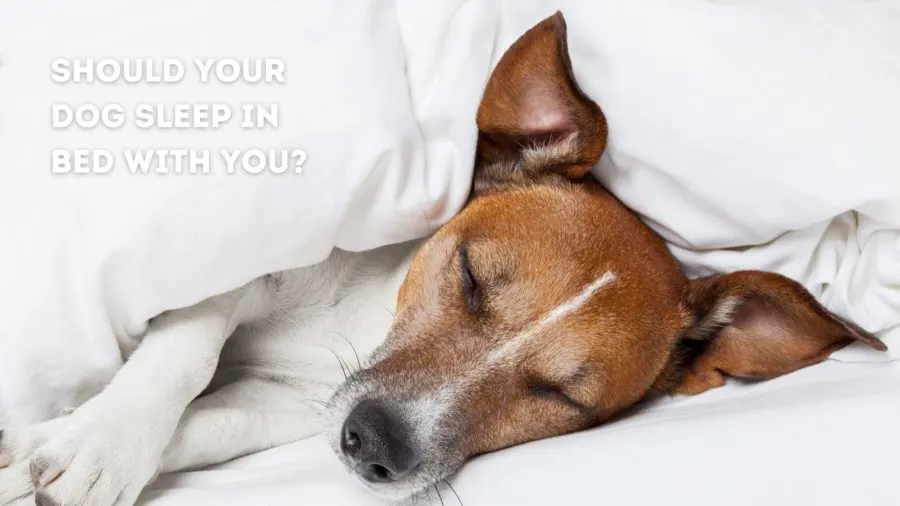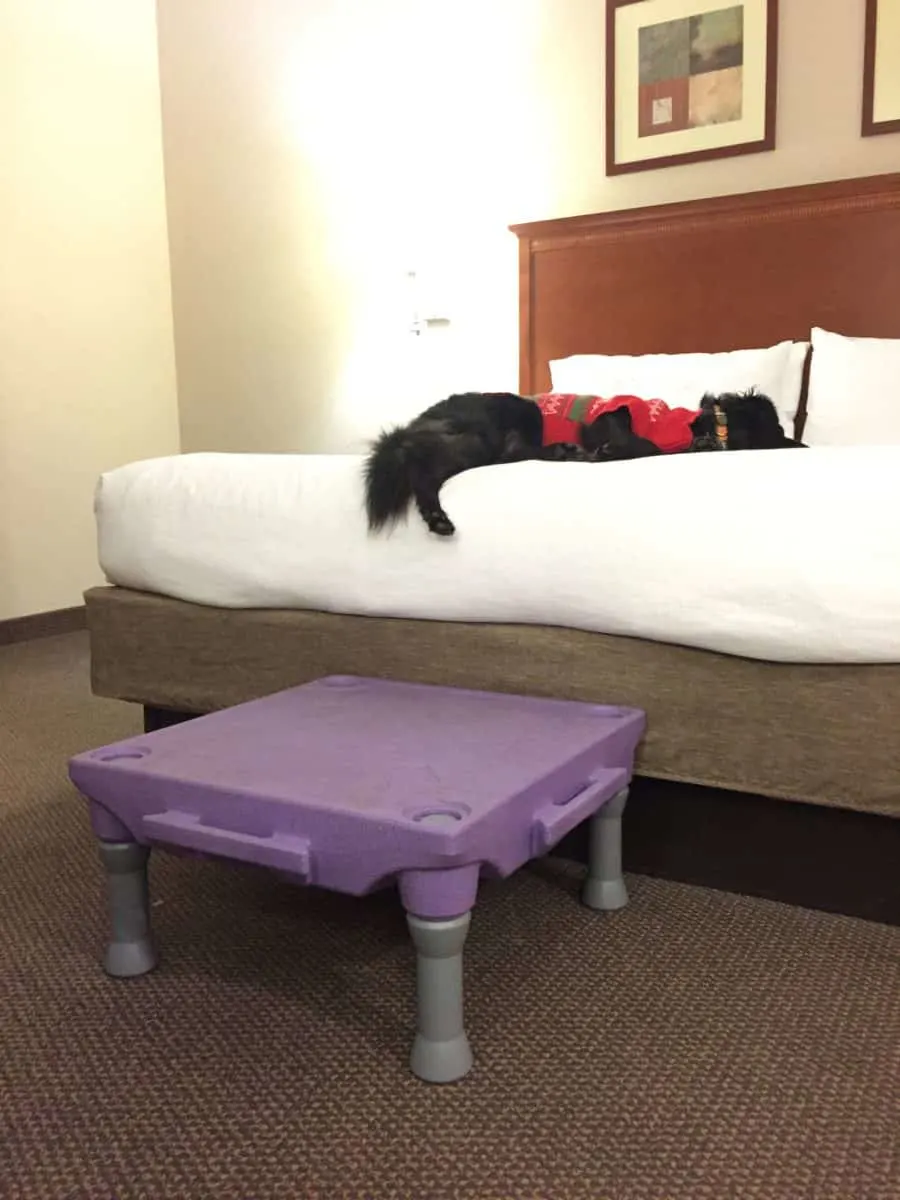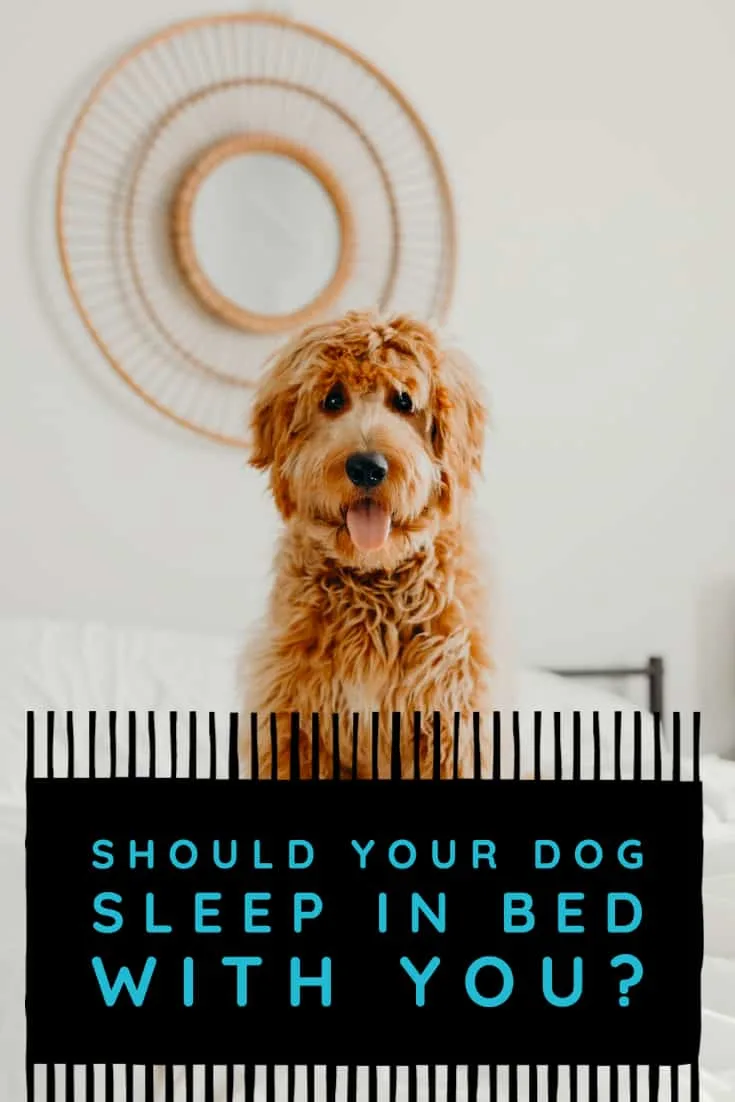Should your dog sleep on the bed–or in a bed beside you or perhaps in a crate? The answer, as with so many things in life, is well, it depends. We’re going to look at advice from the pros for where your dog should sleep, whether a puppy, adolescent or senior.
We all know that, if you lie down with dogs, you just might get up with, not necessarily fleas, but chewed bedding, household items and your own version of Animal House, especially if that dog is a puppy or adolescent. And senior dogs, just like senior people, face their own sleep challenges. And, of course, you have to take your own sleep challenges (and allergy challenges) into consideration as well.

Should my puppy sleep in bed with me?
When we brought Irie and Tiki home from the shelter, we both agreed that the puppies would sleep on dog beds on the floor beside the bed. Our double bed, which had been adequate for two decades of marriage, was tight enough between the two of us and the cat or two among our four who came and went throughout the night. The dogs would do best on the floor of the bedroom on their own beds.
We just forgot to share that plan with Irie and Tiki.
Night after night, moving in slow motion, Irie began to maneuver her way into our double bed until we finally gave in. As Irie grew from puppy stage, the fit was so tight that we decided, eventually, to move up to a king-sized bed to give us room to turn over at night. At least, we thought, Tiki has decided to stay in her own dog bed.
No, Tiki was just waiting for the king-sized bed to arrive so she had a little elbow room.

When we adopted Barli, he immediately decided that he needed to sleep with us. He has slept in our bed every night since his adoption. Even during his puppy period, he was a perfect gentleman, curling up beside us and sleeping through the night.
Today, we sleep with our dogs like jigsaw puzzle pieces in our king-sized bed. We are happy about our co-sleeping arrangement; the dogs settle in quite nicely and usually don’t wake us.
In return, they bring a sense of peace and security to the bed, and the knowledge that, if there’s anything that needs to concern us going on in or around our home, they’ll awaken us.
Although our dogs take up a good portion of the bed, we feel that the tradeoff is well worth it.
Why you may NOT want to sleep with your puppy
As much as we love to sleep with our dogs—as do many other dog lovers—you may not want to sleep with your puppy and there are many good reasons to support this decision.
What you begin in puppyhood will, without considerable work, continue in the years to come after your snuggly puppy grows to his full size.
As mentioned in our case, medium, large, and giant breed dogs can take up a considerable amount of real estate, especially if you have multiple dogs.
The size of your bed may play a large factor in your sleeping arrangements.
Even the height of your bed will be a factor; tall beds can be too much for toy and small breeds and the big jump off a tall bed can be dangerous for breeds with long spines like Dachshunds.
Or you may be concerned about having your own sleep disturbed. A Mayo Clinic Sleep Disorders Center study showed that 53 percent of pet owners surveyed experienced sleep disruption by their pets every night.
Those of us who sleep with dogs know those disruptions can take many forms: snoring, barking, scratching, and that classic bedtime ritual: turning around in circles before settling down to sleep.
Disrupted sleep can cause health issues but that’s not the only health concern.
While zoonotic diseases (ones you get from your dog) are a concern, minor problems such as parasites are more commonplace.
And you know what they say about sleeping with dogs and getting up with fleas? Although usually controlled by flea preventatives, there’s always the chance of a stray flea or tick finding its way into your bed.
Dog lovers with chronic or serious medical conditions often decide that sleeping with a puppy in bed is not the best choice.
Allergies can often be controlled with a HEPA filter in the room but, for some, banishing your puppy from the bedroom for a night of dog dander-free sleep is the only option.
People with compromised immune systems, from anything ranging from chemotherapy treatments to HIV, also often opt to forego a shared bed and instead look to other sleeping situations.
While health and safety concerns are usually related to the people in the bed, they apply to the dogs as well. You may be concerned about rolling over on a small puppy in the night, a danger of co-sleeping, especially with toy and small-sized breeds. Pint-sized puppies sleeping in bed can get rolled on in the night and injured–or worse.
For some, the issue of where to sleep is a matter of training and authority. Some trainers believe that allowing a dog to sleep at the same height as the people in the household will, in the dog’s mind, put the dog on equal footing with the person. Others contend that it’s OK for the dog to sleep in the bed as long as the person asks the dog to join them on the bed, and the dog knows that he needs to leave the bed when requested.
Many pet parents believe that a crate (sometimes accompanied by a stylish crate cover) to replicate the security of a den, is the best choice for sleeping dogs.
Puppies especially often need to start out overnighting in a crate, even if those arrangements change down the road.
During the months of chewing and rambunctious behavior, a crate will prevent your puppy from chewing on electrical cords and wrecking havoc in the house while you sleep.
Crates are usually placed in the bedroom or nearby so you can hear your dog’s cries in the night. With their small bladder size, puppies often need a potty break during the night; a puppy crated within earshot will alert you to the need to go outdoors. Proximity to you also prevents your dog from feeling socially isolated, increasingly important as your dog matures.
Choosing the size of the crate will depend on your puppy’s size—and predicted growth. You can purchase divider panels to make crates smaller during the puppy period, increasing the size of the crate he can access as he grows.
You’ll always want the crate to be large enough for him to stand up and turn around comfortably with at least four inches of headspace when standing.
Where Should Your Adolescent Dog Sleep?

Years ago, Tiki had a habit of chewing the collars off of Irie, especially while we slept. Night after night, she gnawed through every kind of collar until finally we started removing collars at night.
Fortunately, that ended the destruction—but, in many households, that’s not the case. Adolescent puppies have been known to drag pillows off the beds, wreck havoc throughout the house, and most frighteningly, chew through electrical cords as their families slept.
The adolescent period of dog development lasts from about eight to 18 months old, depending on the breed. Like human teenagers, adolescent pups are eager to explore, often in ways that pet parents don’t like—and they just might (like their human equivalents) choose the nighttime hours to do that exploration.
During these adolescent months, your once sweeter-than-sweet puppy may now choose to chew, mark, bark, and otherwise act out while you try to get some shuteye. (Sadly, this period is also the time in his life when a dog is most likely to be relinquished to a shelter.)
Crates are a good option for many families with adolescent dogs. As your dog grows during these teenage months, you can adjust divider panels to increase the size of the crate he can access.
Another alternative, especially if you have large or giant breed teens who can be notoriously gangly during this adolescent period as they grow into those long legs, are exercise pens, in metal, plastic or wood.
These can be reconfigured and easily moved from room to room (or outdoors, too, which makes them popular with RVers and campers to use for doggie daytime naps).
Where Should Your Senior Dog Sleep?

We all know that, as we age, our sleep may suffer. Older people are more likely to wake up in the night for reasons that vary from changing sleep patterns to arthritis to increased urination.
And it’s the same with senior dogs.
Older dogs who are normally in sync with household rhythms (including sleeping habits) may also find themselves facing sleep disruptions as they age. Our own dogs, in their senior years, encountered some changes in sleep patterns.
Irie, who underwent TPLO surgery for a torn ACL, struggled to get comfortable both from the discomfort of the surgery and her around-the-clock Elizabethan collar. She was accustomed to always sleeping on the bed with us, so, as she struggled through 12 weeks of rehabilitation that prohibited climbing or jumping, we did the only thing we could do to accommodate her in our bed: we moved the mattress to the floor.
Other senior conditions, such as arthritis, may necessitate similar, although not quite as drastic, changes, if you choose for your dog to continue sleeping with you.
As dogs age, the height of your bed will be a factor of increasing importance; tall beds can be too much for older canines to negotiate. Many pet parents use steps and ramps to permit easier, safer access to the bed.
Toy and small breeds may no longer be able to jump up to access your bed. Large and giant breeds, prone to hip dysplasia, may struggle as well. Arthritis can challenge dogs of all sizes.
Now that Tiki is a senior with arthritis, we especially tackle this challenge when we travel. While our own bed is very low (and has a permanent step to help Tiki up on the bed), hotel beds can be very tall–and it can be difficult to tell how tall until you actually check into your room.
We travel with a KLIMB table (the legs easily unscrew without tools so it’s it’s easy to travel with). When we reach a hotel bed that’s too tall, out comes the KLIMB.

Dogs accustomed to sleeping in the family bed may want the same privilege when in the care of a pet sitter. Former sitter Lindsey Grant, author of the Sleeps with Dogs: Tales of a Pet Nanny at the End of Her Leash (Seal Press), recalls that owners often asked her to snuggle up with her charges.
“I have found that the biggest drawback to sleeping with senior dogs can be their particular odor. There are two that come to mind especially who smelled, especially around the mouth, like nothing I’d like to share my bed with,” remembers the author. “Ultimately, an equally important factor as age to consider is size. I’d sooner sleep with a geriatric terrier than a Bernese Mountain Dog in his prime.”
Of course, in addition to the comfort of our own beds, there are a growing number of orthopedic beds specially designed for senior dogs. Dog beds constructed with memory foam are designed to relieve pressure on arthritic joints; other beds also feature cooling gel microbeads to help dogs stay cool. And, if your dog has incontinence issues, many such beds also offer waterproof liners and washable covers.
If you are concerned about being awakened by potty runs, indoor pet potties are another option. Placing the indoor pet potty in an exercise pen can help your dog understand the purpose of the potty.
Although they take some training, especially if your dog is not accustomed to using puppy pads, they can help you sleep through the night (and not wrestle with coats and shoes on a midnight winter potty run).
For urinary incontinence, doggie diapers are another option to help you sleep through the night. Sleeping on a waterproof blanket can also help ease your mind about potential accidents.
As always, be sure to discuss any changes in your dog’s bowel and bladder habits with your veterinarian, never assuming that the change is simply due to advancing age.
And, the choice of sleeping with our dogs is one that everyone in the bed needs to make together. “A dog or any other relationship can come between a couple if they are not open and honest about any jealousy or confusion,” notes dog trainer and licensed marriage and family therapist Lisa Peacock. “It does not have to be a problem in a relationship but just like any situation there are always those times that you need to be able to say ‘I want to sleep with just you.’ Your marriage should come first.”
For many of us, though, the choice comes down to family: we want to share our bed with our family members including our four-legged ones. We share our king-sized bed with Barli and Tiki; although they weight about 100 pounds and take up quite a bit of room, there’s always room for family. It’s a fact of life: medium, large, and giant breed dogs can take up a considerable amount of real estate, especially if you have multiple dogs.
There’s no one right answer as to where is the best place for your senior dog should sleep. Like all decisions you make about sharing your bed, the choice of sleeping with your dog or not is a personal one that depends on you, your living situation, and your lifestyle. The best choice is one that works for you—and one that lets sleeping dogs lie peacefully through the night.
Pin it to remember

- Review: Jimmy BX7 Pro Anti-Mite Vacuum Cleaner - December 16, 2024
- 🎉 GIVEAWAY: Lord of the Pets Portrait of Your Dog! - November 26, 2024
- Review: Lord of the Pets Portraits - November 17, 2024
